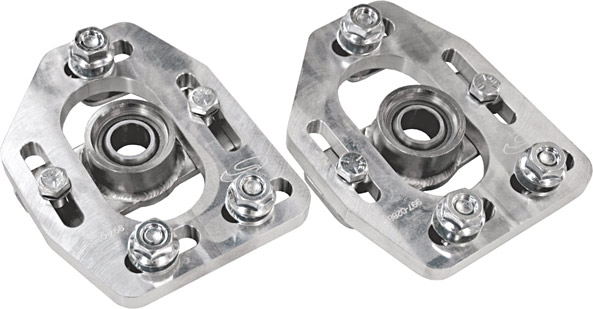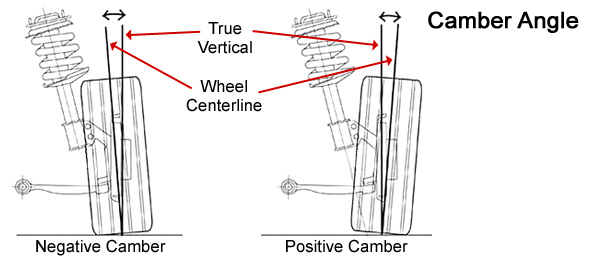Suspension geometry is an extremely complicated science - one that drivers can appreciate when it is "dialed-in" properly, but few really understand the technical science behind it. Even many race teams often guess about suspension set-ups and rely in a trial and error method to obtain optimum performance for their vehicles. Rest assured that the suspension experts at Steeda Autosports , who have been engineering and designing suspension system enhancements since 1988 for the Mustang, have a few tricks up our sleeve on how to achieve optimum Mustang performance.
One easy way to "dial-in" increased handling of your Mustang is to install a set of Mustang Camber Caster Plates or Mustang Strut Mounts and adjust your Mustang suspension so that you have more precise control of your suspensions behavior - but beware - not all Mustang Camber Caster Plates / Mustang Strut Mounts perform like they should and there are considerable differences in their engineering, component quality, and most important, their safety.

Fundamentally, the idea of the Mustang Camber Caster Plates / Mustang Upper Strut Mounts is to provide increased camber and caster adjustments so that a more aggressive wheel alignment can be "dialed-in" so as to enhance a vehicles cornering or rolling ability. The principal notion is to maintain as much tire contact as possible during aggressive street driving or whenever you are on the track and to minimize tire rolling resistance when you are at the drag strip. Following is a summary of camber and caster and how it can make a sizable difference in your car's performance:
Camber angle is the angle made by the wheels of a vehicle. Specifically, it is the angle between the vertical axis of the wheels used for steering and the vertical axis of the vehicle when viewed from the front or the rear. If the top of the wheel is farther out than the bottom of the wheel (e.g. away from the axle), it is called positive camber; if the bottom of the wheel is farther out than the top, it is called negative camber.
[caption id="attachment_1952" align="aligncenter" width="593"] Camber Diagram[/caption]
Camber Diagram[/caption]
The camber angle plays a key role in altering the handling capabilities of a vehicle's suspension for both road racers and drag racers:
- For Mustang road racers, negative camber improves grip when cornering. This is because it places the tire at a better angle to the road, transmitting the forces through the vertical plane of the tire rather than through a shear force across it and maintaining a proper contact patch.
- For drag racers that want optimum straight-line acceleration, the greatest traction will be attained when the camber angle is zero and the tread is flat on the road.
Proper management of camber angle is a major factor in suspension design and must incorporate not only idealized geometric models, but also the real-life behavior of the components; flex, distortion, elasticity, etc. What was once guesswork has now become much more scientific with the use of computers, which can optimize all of the variables mathematically instead of relying on the designer's intuitive feel and experience. As a result, the handling of cars has vastly improved over the years with dramatic results.
In cars like the Mustang that utilize a McPherson Strut front suspension, camber angle is fixed at a set degree. The elimination of an available camber adjustment may reduce maintenance requirements, but if the car is lowered by use of Mustang lowering springs, the camber angle will change. Excessive camber angle can lead to increased tire wear and impaired handling - a problem with may cars where their owners mix and match various components from differing suppliers in their quest to improve their suspension.
Caster angle is the angular displacement from the vertical axis of the suspension of a steered wheel measured in the longitudinal direction. It is the angle between the pivot line (the imaginary line that runs through the center of the upper ball joint to the center of the lower ball joint) and vertical. Road racers sometimes adjust their car's caster angle to optimize their car's handling characteristics in particular driving situations. When a vehicle's front suspension is aligned, caster is adjusted to achieve the self-centering action of steering, which affects the vehicle's straight-line stability. Improper caster settings will cause the driver to move the steering wheel both into and out of each turn, making it more difficult to maintain a straight line.
Excessive caster angle will make the steering heavier and less responsive, although, in racing, large caster angles are used to improve camber gain in cornering.
[caption id="attachment_1954" align="aligncenter" width="593"] Caster Diagram[/caption]
Caster Diagram[/caption]
If all of this sounds very confusing, worry not - because at Steeda Autosports - we take the guesswork out of dialing in your suspension and offer many great components and alignment specifications that are specifically tuned to work together to maximize your performance. Remember, we are not newcomers in this arena, as we have been working on improving Mustang suspensions continuously since 1988 - longer than any other Mustang performance company in history and we manufacture a comprehensive line of Camber Caster Plates and/or Upper Strut Mounts for your application.
Following are just some of the key qualities/features that we engineer and manufacture into our Mustang Camber Caster Plates that we sell:
- We are confident with the engineering and quality of our Camber Caster Plates that we offer a free Lifetime warranty is free with ALL of our caster camber plates
- We use a Teflon-lined spherical bearing that is entirely custom designed for our applications. It is not an "off the shelf part" readily available - rather we took the time to have a special unique part that also provides the level of optimum performance and durability we demanded for street and track applications.
- A special 8,000lb rated stainless steel Spirolock snap ring is used to secure the bearing into the housing - this ensures that the bearing stays where it is supposed to and not fail.
- Our 4 bolt plates also use 7075-grade aluminum - This much higher cost aluminum alloy is strong, with a strength comparable to many high-grade steels, and provides very good fatigue strength and less resistance to corrosion than many other aluminum alloys.
- Our plates allow for independent adjustment of caster and camber for better alignment (caster is not adjustable from the factory setting) and are a direct bolt-in application - No modifications required
In summary, the Benefits for using these plates/mounts include:
- Dial in more negative camber for better cornering
- Straighter tracking and better high-speed stability
- Better steering response, quicker turn in
- Holds precise alignment in ALL driving conditions
- Less friction than stock bushings
- Offset bushings allow custom adjustment of strut height
- Increase suspension travel on lowered vehicles
- No interference with hoods or strut tower braces - a common problem with some other brands
Many people will ask us if there indeed are differences in Camber Caster Plates or Upper Strut Mounts. Suffice to say - indeed there are. While others may use inferior materials or assemble their parts in foreign countries or under less than ideal manufacturing conditions, at Steeda Autosports, we use only the finest materials in the construction of our parts, and we do that under strict ISO 9001-2008 Certified Standards. Just ask around how many others do the same - and you will find out that there are no other aftermarket company that go to the extremes that we do to build quality parts here in America under strict ISO Standards. Nobody else!
Why do we go to such extremes? Here is an example of a very popular Camber Caster Plate from manufacturer "ABC" that a customer purchased and installed on his car. We became aware of this when recently at our Pompano Beach facility, a Mustang was towed in that had suffered a complete failure of a Camber Caster Plate with devastating results. In this specific example, the Camber Caster Plate bearing retainer failed, causing the strut to literally punch its way thru the retainer and separate - you can only imagine the damage that occurred to the vehicle and the shock the driver had when it failed. Thankfully, the driver was able to somehow maintain partial control of his car and bring the car to a safe stop - nevertheless, the results could have been even more catastrophic.
[nggallery id=188]Hopefully, you now have a slightly better understanding of Mustang Camber Caster Plates and Mustang Upper Strut Mounts and how that can dramatically improve the handling and performance of your Mustang. To assist in optimizing your vehicle's performance, feel free to check out www.steeda.com or call us at 954-960-0774 and talk to one of our Performance Experts and see what we can do to improve your vehicle's suspension system today!
Steeda - Speed Matters


